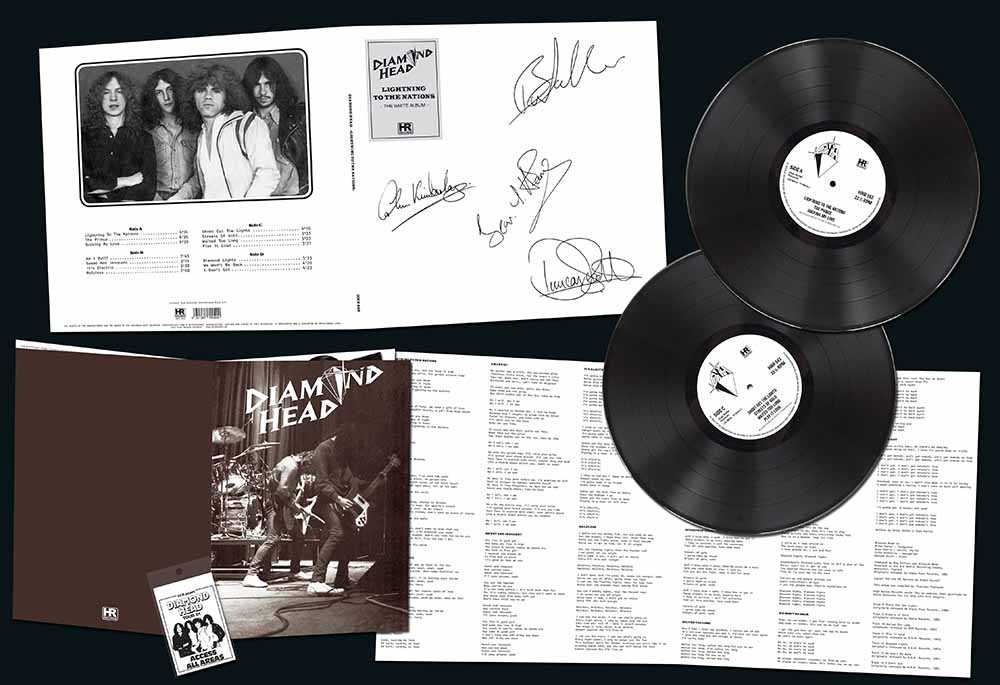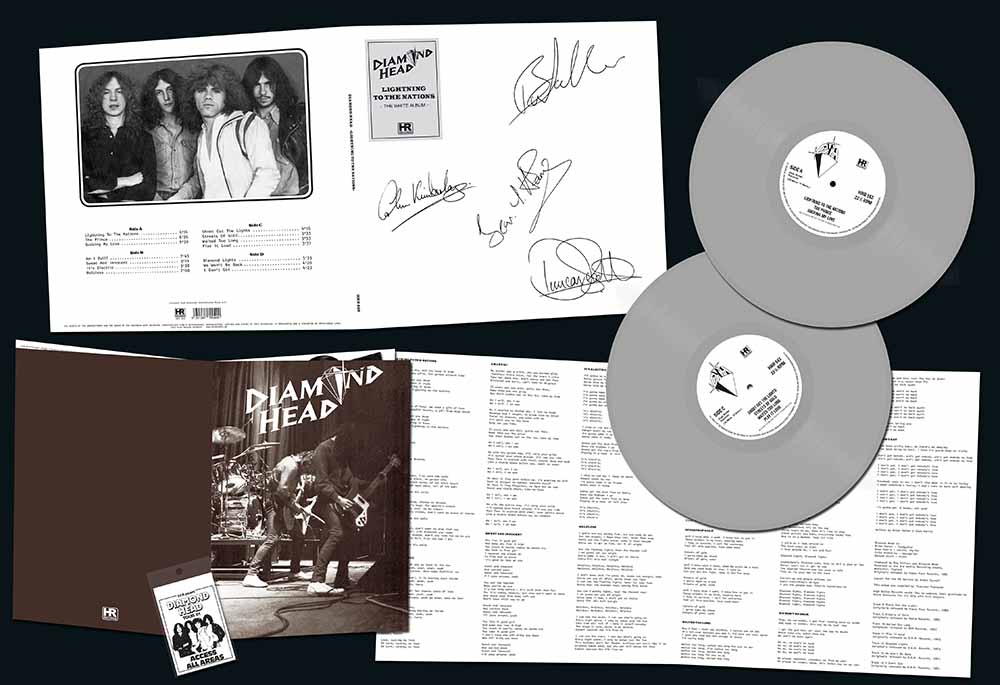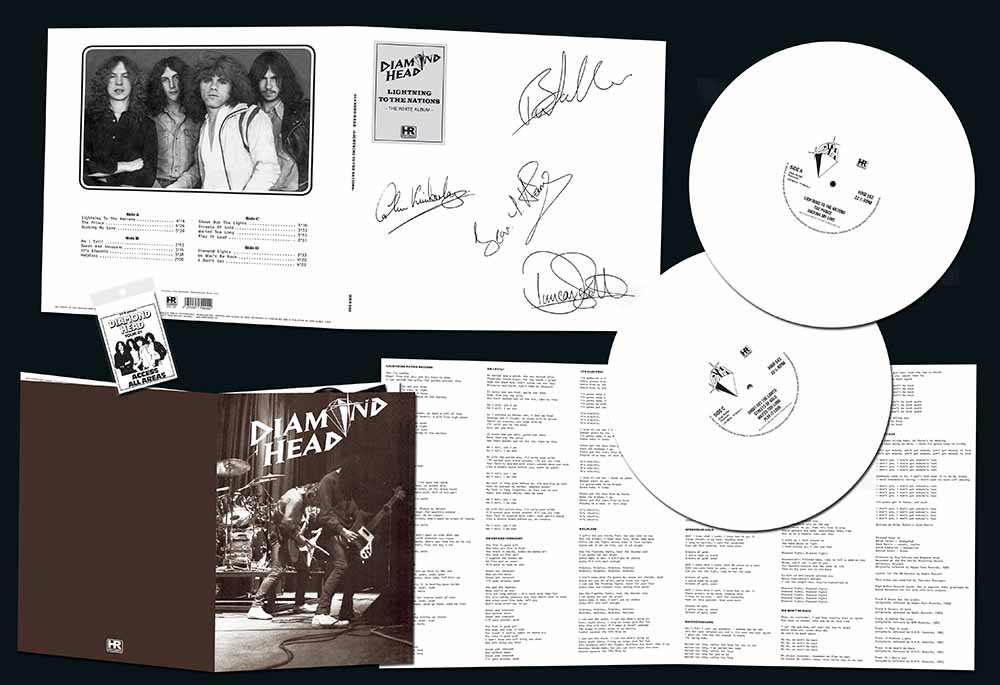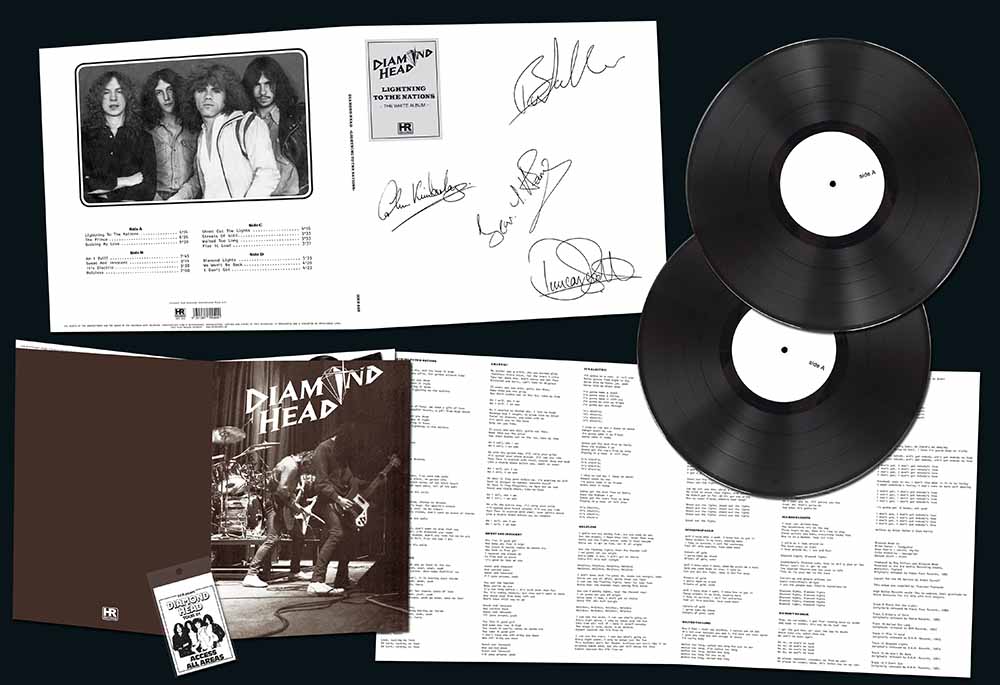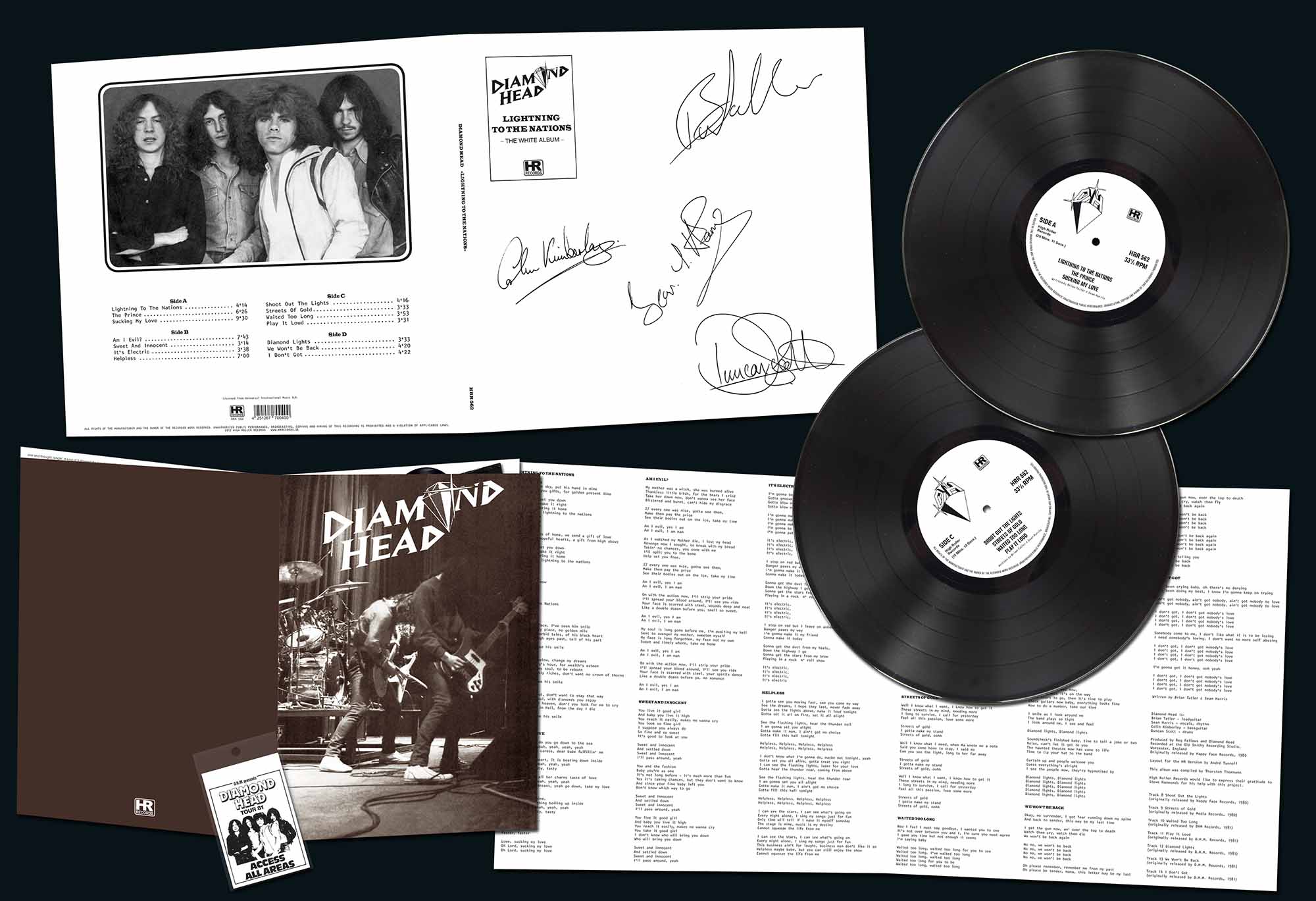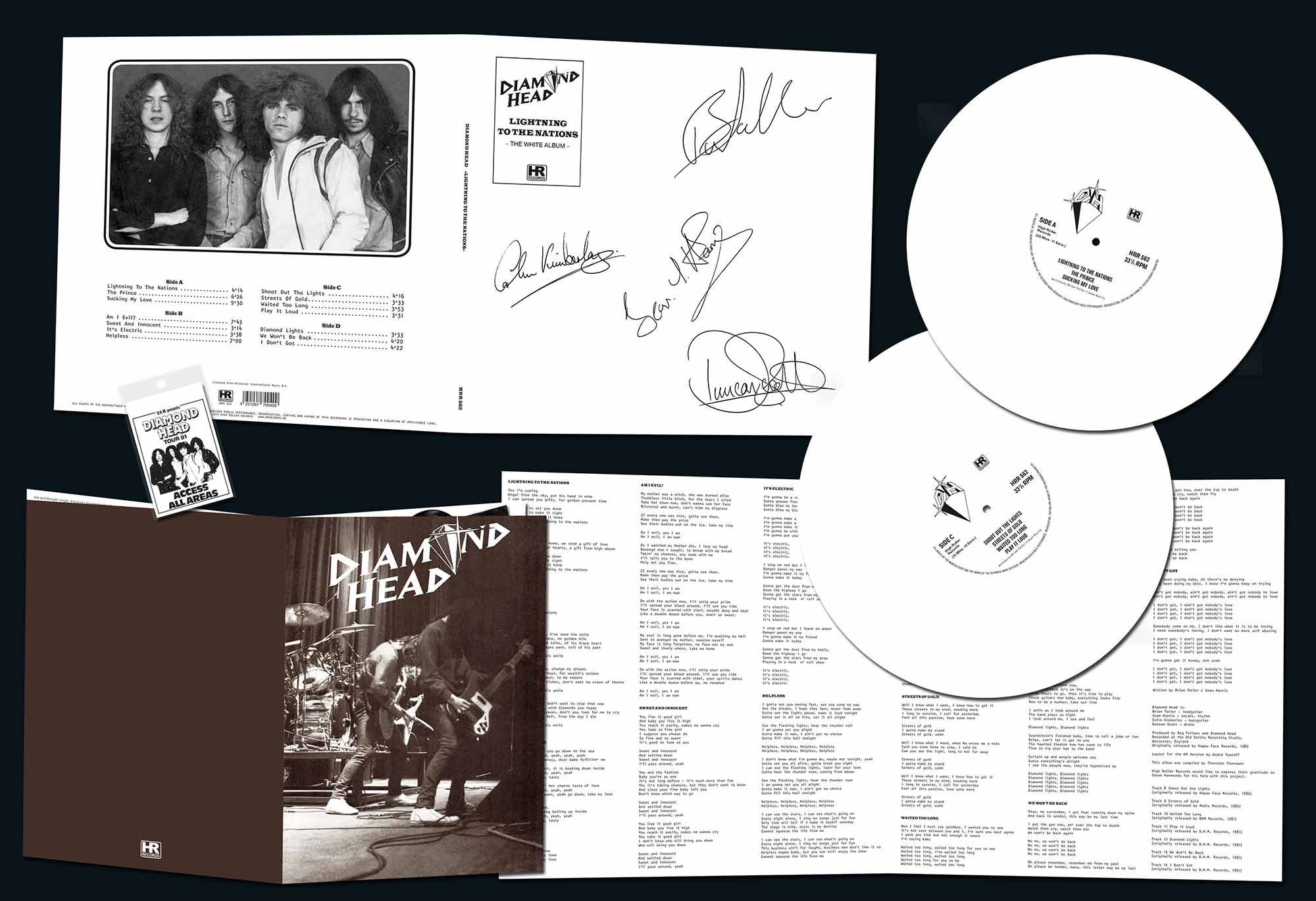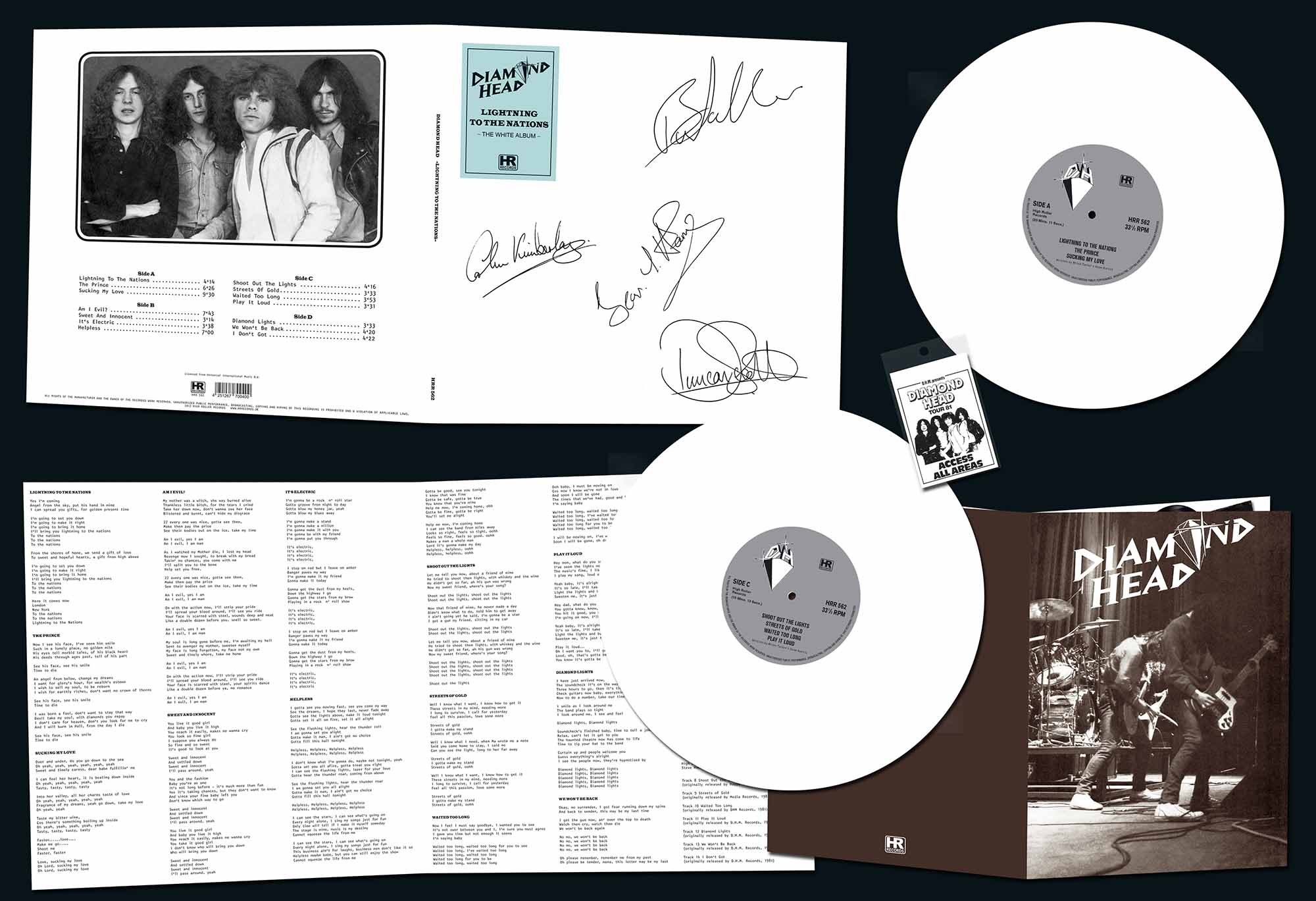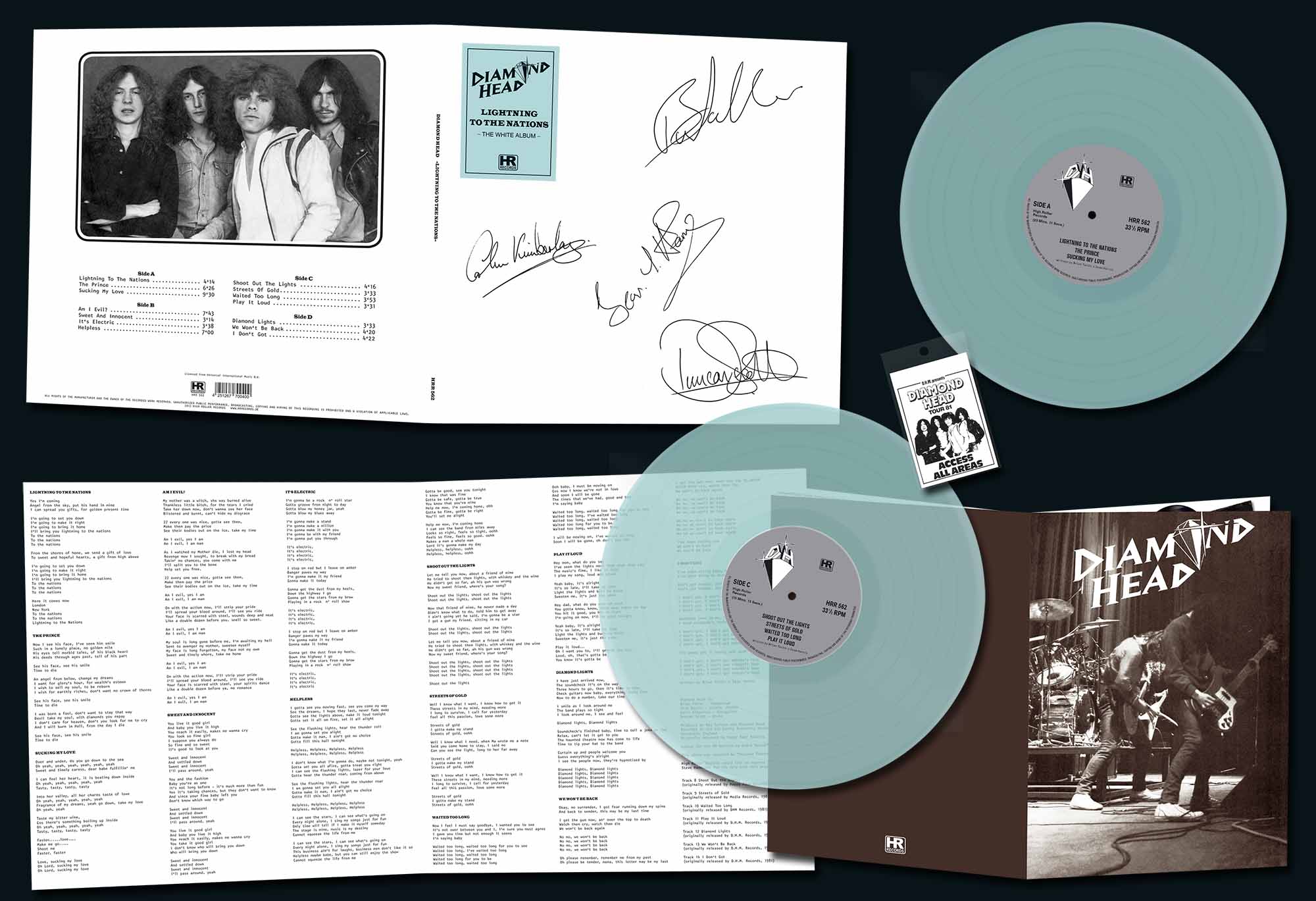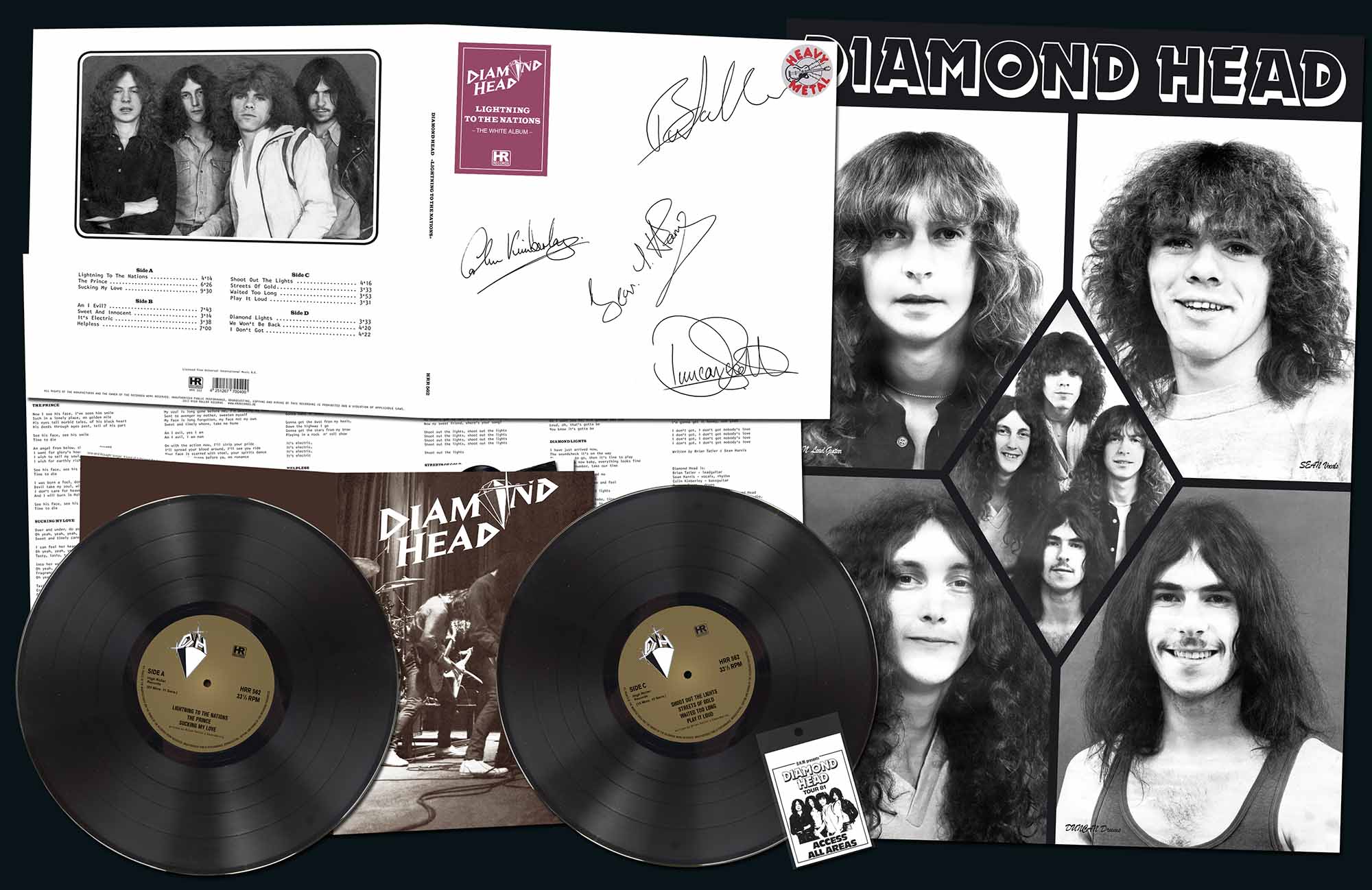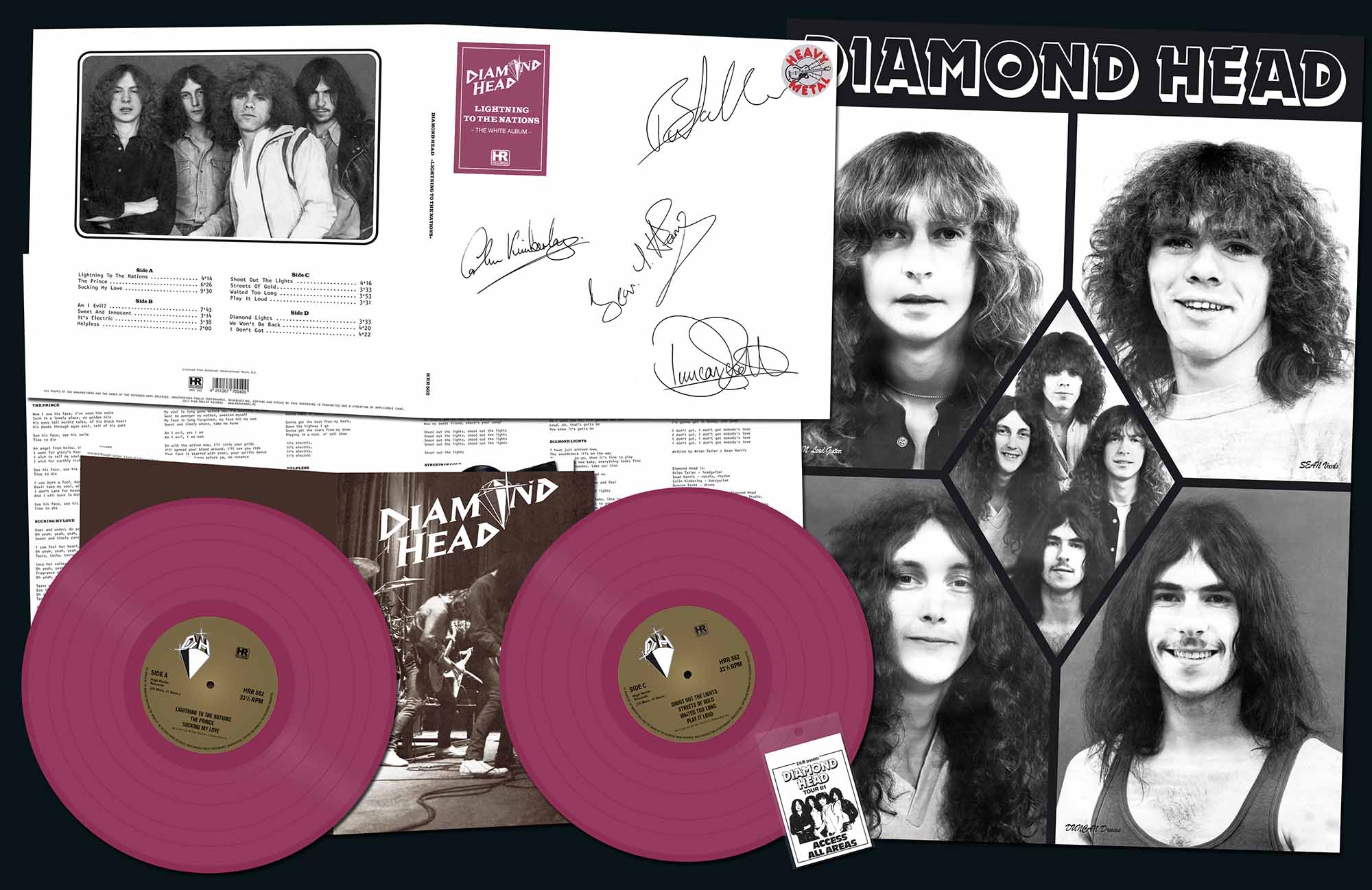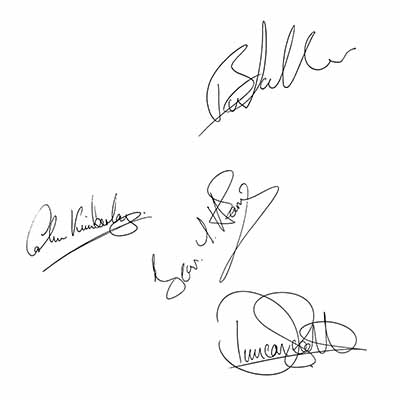 | ||||
| DIAMOND HEAD - Lightning to the Nations - The White Album DLP | |
HRR 562, ltd 1000, 150 x silver vinyl (HRR mailorder exclusive), 400 x white vinyl + 450 x black vinyl, gatefold cover, A4 booklet, tour pass replica, 2nd pressing: 150 x black + 350 x white vinyl, 3rd pressing: ltd 1000, 250 x black + 350 x white + 400 x transparent electric blue viny, 4th pressing: ltd 500, 250 x black + 250 x grimace purple vinyl, gatefold cover, A4 booklet, tour pass replica, POSTER and Heavy Metal sticker on front cover | |
| Sean Harris - Vocals Brian Tatler - Guitars Colin Kimberley - Bass Duncan Scott - Drums | |
| 01 Lightning to the Nations 02 The Prince 03 Sucking My Love 04 Am I Evil 05 Sweet and Innocent 06 It's Electric 07 Helpless | 08 Shoot Out the Light 09 Streets of Gold 10 Waited Too Long 11 Play It Loud 12 Diamond Lights 13 We Won't Be Back 14 I Don't Got |
SOLD OUT! NO REPRESSING | |
specially mastered for vinyl
Lightning Strikes
Although it hadn’t originally been intended as a commercial release the album was soon being reviewed, given airplay and sold as a proper Diamond Head product… The record stood head and shoulders above most of the independently-produced (and much of the major-label tat) vinyl being churned out by amateur-hour combos, with short punchy tracks such as ‘It’s Electric’ and ‘Sweet And Innocent’ sitting happily alongside lengthier, more convoluted numbers such as ‘Am I Evil?’ and ‘Sucking My Love’.
Malc Macmillan, ‘The NWOBHM Encyclopedia’
Possibly the most famous – and almost certainly the most influential – record of the New Wave Of British Heavy Metal, Diamond Head’s ‘Lightning To The Nations’ or ‘White Album’ (as some of us referred to it at the time) was recorded and released with little fanfare in 1980, in a run limited to just 1,000 copies. The original plan was to hawk it around the majors, but with manager Reg Fellows being repeatedly told to shut the door on the way out the band decided to release it themselves, and from such small beginnings was born a legend.
As Malc Macmillan goes on to point out, “it’s hard to say just why it was all so effective, but an astute (if commonly offered) opinion of later years was ‘Diamond Head were greater than the sum of their parts’. True, they had the most formidable vocalist of the NWOBHM genre (and the rock world in general), plus one of the most innovative and skilful guitarists, but the quietly-assured rhythm section appeared to be just as important to the bigger picture; any bassist or drummer worth their salt will happily inform you that there were some highly individualistic examples of musicianship going on at all levels.”
The band’s settled line-up had only been in existence for two years by the time they ventured into the studio to record their debut album. It was January 1978 that Colin Kimberley finally joined founder members Brian Tatler (guitars) and Duncan Scott (drums), and frontman Sean Harris, on the understanding that if he bought a bass Tatler would teach him how to play it. Shows around the Midlands and demos led to a single ‘Shoot Out the Lights’ b/w ‘Helpless’ recorded in December 1979 and released on 1 February 1980, and as the NWOBHM grew in size and stature gigs wider afield starting slotting into place, including two supporting AC/DC at the Newcastle Mayfair and Southampton Gaumont (on 25 and 27 January 1980) and the opening slot on the Metal For Muthas tour with Iron Maiden and Praying Mantis at London’s Lyceum Ballroom on 10 February. Although not their first gig in the Capital, their short four-song set (‘Am I Evil?’, ‘Sucking My Love’, ‘Helpless’ and ‘Lightning To The Nations’) enthralled Sounds’ Geoff Barton who followed the band up with a full page article in the music paper a couple of weeks later. “‘Am I Evil?’ is the band’s best song (a demo version is already the bane of the Sounds’ office) and I was glad to hear them start the set with it,” he wrote with rare enthusiasm. “Diamond Head numbers are rarely under six minutes long and some (like ‘Sucking My Love’) last for close on ten…” he continued, before turning in the often (mis-) quoted “there are more good riffs in your average single Diamond Head song than there are in the first four Black Sabbath albums.” With their single selling well at gigs, and such positive reviews ringing in their ears, recording an album seemed like the most logical next step for a band who consistently aimed high.
We had written 100 songs, and played nearly 50 gigs, by the time we went back to the Old Smithy on 17 March 1980 to begin recording our first album ‘Lightning To The Nations’ so the seven songs chosen were the cream of our live shows.
Brian Tatler, ‘Am I Evil? – The Music, The Myths & Metallica’
Tatler remembers that the band were confident in their choice of material for the album. “I think we knew it was good. It all sounded good. ‘Am I Evil?’ sounded amazing in the studio, and I’d never really heard that kind of quality before. We’d done the single ‘Shoot Out The Lights’ but that was done in one day or a day-and-a-half, and it was all a bit rushed. But that was done in the same studio so when we went back to The Old Smithy to record ‘Lightning To The Nations’ we already knew the place, and we had a week to do it in. It sounds like nothing now to record and mix an album in a week but it was quite luxurious for us! We could take our time a little, although I do remember that we tried to get the drums, bass guitar and rhythm guitar down in one take if possible; not too much stopping and starting. And because we’d played all the songs live they were pretty much rehearsed and tight and there wasn’t hours of us going ‘oh, that bit doesn’t sound very good’ or full-on re-writing in the studio, as you do when you get older!”
So on Monday 17 March 1980 the band rolled up once more at the familiar studio in nearby Worcestershire. “The Old Smithy was quite impressive to us because it was twenty-four track,” Tatler told Neil Jeffries in the Kerrang! Kollector’s Klassic supplement in issue 478. “I remember the studio was very ‘dead’. It had this drum booth which was carpeted and when you hit the drums they just went ‘thud thud’. At the time we thought it was horrible but we just let it go…The album was engineered by this guy called Paul Robbins... He’d just sit there with a newspaper and we’d go, ‘how was that?’ and he’d say ‘seemed all right to me…’[laughs"> It wasn’t very well produced but in the studio it sounded great. The stereo guitars sounded fantastic! I can’t remember mixing it. It was probably all done for us and we just said ‘okay’.
“We didn’t think that much about it, I mean, the songs just went on it without too much thought for running order and things like that. It’s not that ‘Lightning To The Nations’ was the obvious opener on the first album; it just had that hook, and besides, look at the length of the songs! ‘Sweet And Innocent’ wasn’t an opener, and we figured we couldn’t open with an eight-minute song. And anyway, ‘Lightning To The Nations’ is a classic NWOBHM song.”
Sean Harris quoted in ‘Suzie Smiled… The New Wave Of British Heavy Metal’ by John Tucker
The songs themselves have become the stuff of folklore. Metallica’s patronage – covering four of the album’s seven tracks – has certainly helped, but a great song is a great song however you slice it, and there’s not one duff track on ‘Lightning To The Nations’ which of course opens with that classic title track. “This was the obvious opener – short, sweet, punchy,” says Tatler, contradicting what Harris had said in my book ‘Suzie Smiled…’. “I also think it’s pretty original, even now. I don’t think there’s a lot of other songs around that sound like it. It’s an amazing track, a lot of tempo changes and things, it goes up and down, there’s a complicated riff. I almost don’t even know where some of that came from, if I’m honest. Sometimes you just get lost in the moment when you try to create and things just come, and maybe Sean would have said ‘that bit there is good’ and ‘don’t play it like that, play it like this’ and ‘turn that bit around’ and things would just ‘appear’. So I do sometimes wonder how we created some of those songs at the time because they are pretty original and, yes, we had our influences but you can’t say that ‘Lightning To The Nations’ sounds a bit like ‘X’, because I don’t think it is like anybody in particular. It’s very original, very fresh. The only bit I can remember thinking is a bit like somebody else, if you want to be picky, is the middle eight, the bit where I’m playing the octave note repetitively and there’s chords underneath it; it’s a tiny bit like ‘Bad Boy Boogie’ where Angus is playing one note repetitively. So it might have come from a bit of AC/DC, that middle eight, but then, we all liked AC/DC. Maybe that had an effect on us,” he laughs.
Next up comes ‘The Prince’, another song Tatler thinks is “pretty original” and another song which he cannot recall too well almost forty years later. “I know a lot of it is Sean’s input, but again I don’t know where some of those riffs came from. We were listening to all sorts of things but it’s not really like anything that was around at that time. I think the speed, the aggression, and all that might have come from bands like Judas Priest, trying to get some adrenaline going, some excitement, because all these songs were road-tested and had to pass the ‘live test’. We would play them at gigs to people who didn’t know anything by the band – probably never seen us before – and if the song went down well live it would gain confidence within the band and we’d start thinking ‘well, OK, if the crowd like it, it must be good!’ and it would stay with us. If it went down badly we would scrap it. But because it was fast I think ‘The Prince’ would usually get a pretty good reaction. I think it was probably one of the later songs. In fact, I would say that ‘The Prince’ and ‘Lightning To The Nations’ were maybe the last songs written before we went into the studio and recorded that album.”
The final cut on Side One is certainly a song of its time. The early Eighties was a time when there was a growing awareness of the impact of sexism in music; as young lads most of us dismissed this at the time, but looking back now you can see how cringingly awful some of, say, Ian Gillan’s and David Coverdale’s lyrics really are. With all this going on around them Diamond Head chose to wrap up the first side of the LP with the completely unsubtle ‘Sucking My Love’. Would Tatler write such a song now? “No chance!” he snorts. “No chance! It is a big track though, isn’t it?,” he concedes. “It’s young men with a lot of confidence, balls to the wall, fingers in the air and if you don’t like it, fuck off! It’s that kind of attitude. It’s a bit ‘us against the world’. Obviously, it’s un-PC and it’s long and it doesn’t fit into a lot of formats, but I think back then we just didn’t care. We really liked it, it’s a great riff and we just went with it. The band was tight, four guys who got on really well with each other – we could be critical of each other and not get upset and storm off and all that – so we would just keep working and crafting songs until they were ready. We took a lot of time because that’s all we lived for: the band.” As for the lyrics, Tatler didn’t bat an eyelid at the words that Harris came up with for the song. “No, I didn’t mind at all. I always let Sean have a free reign with his lyrics because I always thought that I couldn’t do any better. There’s no way I’m going to tell Sean ‘that’s not very good’ or ‘I don’t think you should sing that’ because I knew I couldn’t do any better. Who am I to criticise his lyrics? So I said ‘if you’ve got the nerve to sing that…’ And the same was true with ‘Am I Evil?’ Starting the song off with ‘My mother was a witch, she was burned alive…’ was pretty strong stuff...”
…And is possibly the greatest opening line of all time. At nine-and-a-half minutes ‘Sucking My Love’ took up almost half of Side One; flipping the record over you’re immediately hit with the album’s striking tour-de-force, the legendary ‘Am I Evil?’, in all its seven-and-a-half minute glory.
Tatler laughs. “Masses of music coming at you, isn’t it! But that opening line is really setting our table out – y’know, ‘check this out!’ It’s the song I am most proud of. It seems to be the choice of most people, the one they always want to hear; it’s the one they shout for at a gig. OK, you get the clever dicks who come up with an obscure track, like ‘Trucking’ or something that we rarely do, but 99 times out of a hundred it’s ‘Am I Evil?’ It’s our big song; that’s what it’s become. It’s got a life of its own, it travels the world thanks to Metallica, and it’s a rock classic, I think.”
In ‘Suzie Smiled…’ Tatler pointed out that he “wanted to write a song that was heavier than ‘Symptom Of the Universe’… I think it started with my riff and Sean and Colin both liked it straight away – I personally like the way it’s the same riff over and over again for about two-and-a-half minutes with just the key of it and the drum pattern changing. We linked it to the fast section later which was probably another song we had in the pipeline, and then the intro was added which of course was inspired by ‘Mars’ from the ‘Planet Suite’. And finally came the guitar solo which I didn’t finish until we were in the studio, just in the nick of time!”
The question has got to be asked: do you ever get bored playing it? “Nope!” Not ever? “No, not ever. I’m glad we’ve got it. I’m glad it’s in the set because you know that if nothing else excites the punters, that one will. And if you’re having a good gig from the off, by the time you get to ‘Am I Evil?’ it’s going to be insane.”
Back to the album, after ‘Am I Evil?’ things finally gear down a tad with ‘Sweet And Innocent’. As a song it screams ‘single’ from the off and in that respect is the best stab at commerciality that the band ever made – not as fluffy as ‘Waited Too Long’ nor as contrived as ‘Call Me’, the band’s first single for MCA Records. It was later re-recorded and issued as the band’s second seven-incher, although for the single version the band worked with a ‘real’ outside producer for the first time, and in his autobiography Tatler describes Robin George’s production “as making Sean sound like he was singing down a drainpipe.”
“I do feel our brains might have been in the mode of ‘we ought to try and write a single’,” recalls Tatler. “I don’t remember having that conversation but because the song evolved that way and everyone thought ‘well it’s short, and it’s got a good chorus’ it would be an obvious single. I think I’ve read somewhere that Black Sabbath fell into that position with ‘Paranoid’. It happened to be the short track on that album so it became the single – not necessarily that they’d written it to be a single, it just was ‘the short track’. And I think ‘Sweet And Innocent’ functioned in the same way: because it was short and it had a good chorus everybody pointed at that one and thought ‘single’. It kind of it showed the band in a different light as well, and it was very popular live too.”
‘It’s Electric’, the song first favoured by Lars Ulrich from its appearance on MCA Records’ ‘Brute Force’ compilation and which pretty much sowed the seeds for Metallica, takes the tempo back up once more. Tatler nods. “I mentioned AC/DC earlier, and that they were favourites of ours. I mean, we didn’t want to sound like them, there’s more to the rock spectrum than just sounding like AC/DC, although ‘It’s Electric’ is a fairly good homage to the Young brothers. It’s the shape of the riff. It’s ‘stoppy’, it’s ‘gappy’, and it was the first time we’d employed that songwriting technique. I’d been listening to songs like ‘Problem Child’ where the guitars keep stopping and leaving room to breathe, to hear the drum beat underneath; we really liked that, so we tried to come up with a riff that would have that ‘air’, and ‘It’s Electric’ was the song where it worked. We might have had a couple of aborted songs before that but once we’d got ‘It’s Electric’ we all thought ‘yeah, that’s great’ and it went straight into the live set and never really moved out!
“And it’s the oldest Diamond Head song on record,” he continues. “I kept a kind of inventory of all the songs we wrote and tried to name and date them from 1976 onwards, and that song was written in 1978 and I think it was song number 43. Nothing before that ever made vinyl, and has ever been heard by anybody really except the band. So that was the first. And the second is ‘Wild In The Streets’ which didn’t come out till ‘Death And Progress’; it didn’t make ‘Lightning To The Nations’ even though we’d got it at the time; we also had ‘To Heaven From Hell’ and ‘Dead Reckoning’ – we just kept anything we liked as ‘spares’, thinking ahead to the next album or EP or whatever. When we signed to MCA they started demanding EPs and things, and it really soaked up the tracks then. We didn’t realise how many songs you needed until we actually signed to them.”
The album closes with ‘Helpless’, another of the band’s adrenaline rush songs and written in an attempt to be the fastest song around at the time. During the research for Tatler’s autobiography drummer Karl Wilcox did the maths and concluded that at approximately 276 beats per minute ‘Helpless’ is faster than ‘Overkill’ (236bpm) and ‘Exciter’ and ‘Kill The King’ (262 bpm) although was later outstripped by ‘Ace Of Spades’ (280 bpm). However, before the album appeared a shortened version of the song had already backed the band’s first single ‘Shoot Out The Lights’ in 1979.
“That was just an edited version for the single,” confirms the guitarist. “We had the long version first. In fact, it started, I think, with the front section where it goes up to the second chorus, and then we had another song with a riff that I’d come up with, the middle eight bit which I think had a different title, something like ‘Come Again’ or something, and we decided one day just to stick the two together – as you do! – weld a little section between the two songs, and at a later date we came up with the ending as well which is another different time signature and another different drum beat. So now we had this big song which was nearly seven minutes long. But when we did the first single we thought that both songs would have to be about three minutes. ‘Shoot Out The Lights’ was the obvious A-side but all our other songs seemed to be fairly long so we thought we’d do just the short bit of ‘Helpless’. It had a fade-out on the single,” he chuckles, “so we obviously didn’t have an ending at that time; we had nowhere to go! We did a short version of it on the BBC TV programme ‘Look Hear!’ [later made available on the ‘Official Bootleg’ DVD"> which was again a three-minute version; we stuck a little guitar solo in it as well. But the actual song is the whole seven minutes – that was what we were aiming for.”
Although the songs were always credited Sean Harris/Brian Tatler it was never a straight split with the vocalist providing the lyrics and the guitarist the music. “In terms of the lyrics,” says Tatler, “as I said earlier, that was mainly Sean. All I ever did was come up with the odd title or the odd little suggestion, but Sean did 98% of the lyrics. In the early days I started out doing most of the music but as Sean got better on the guitar he started writing more and more too, and eventually maybe he’d come up with a really good riff and between us either I would come up with the main riff or Sean would come up with the main riff and after a while it was like ‘right, we’ve got another song going here’. We were great together, Sean and I, the way we could write and bounce off each other and add to each other’s ideas: say, if Sean had a verse idea I’d come up with a chorus idea or vice-versa, so Sean did have a lot of input to the music and the arrangements, as well as doing virtually all the lyrics.”
Desperate times call for desperate measures! It was different to the traditional demo tape approach. We’d had a bit of interest, MCA sniffed around back then, but nothing concrete so we decided to put it out mail order to help build up the fan club and merchandising.
Sean Harris quoted in ‘Suzie Smiled… The New Wave Of British Heavy Metal’ by John Tucker
The plan, now that the band had a complete album in the can, was to take it to the majors and show them what the band could do, but there things came unstuck. “They just didn’t want to know,” says Tatler. “It’s different now, but what we didn’t know back then was that record companies want to be involved at every step.” In his autobiography, Tatler notes: “It’s a shame they all passed on it because in hindsight the album is seen as a classic and was actually cutting edge stuff, but what were we to do? Reg decided that ‘if the record companies don’t want the album we’ll release it ourselves,’ possibly getting caught up in the outlandish success of the independent labels at the time. In 1979 Stiff Little Fingers sold 100,000 copies of their debut album on Rough Trade, the first independent album to go Top 20…”
Whereas Led Zeppelin, one of the band’s collective idols, had pretty much cornered the market in putting as little information as possible on their album sleeves, Diamond Head took the approach to the extreme. Having pressed 1,000 copies of the album off their own bat, they encased it in a plain white cardboard sleeve (it was handy that Fellows was the owner of a cardboard manufacturing plant) with a plain white record centre. There was absolutely no information on that first pressing. Nothing at all. The only concession was that each band member autographed 250 copies – presumably not in one sitting… “Though not intentional,” wrote Tatler in his autobiography, “the white sleeve and lack of information added to the record’s mystique, and we felt we could then be judged solely on our music.” The album was sold at gigs and via mail order with adverts in Sounds starting to appear in July 1980. When the first 1,000 copies sold out, a second run (done in time for their tour with April Wine in January 1981), again of 1,000 LPs, would carry a centre label, but again appear in nothing but a plain white sleeve. Those two pressings – 2,000 copies in total – would be the only copies made of the original album, despite what some band members would later claim in interviews.
In late July I sent off a £4.00 postal order for a special limited edition LP by Diamond Head… Just over a week later, the album arrived OK and I’m highly impressed with the music and quality. So what’s the snag? I’m very puzzled and annoyed with the total lack of information included. The cover is just plain white, with an indecipherable scrawl across it – no track listings, no picture cover, no details of where and when it was recorded…
Letter in Sounds, 30 August 1980 by Geoff Wilberforce, Stockton
Geoff Wilberforce’s letter to Sounds’ was published in the music paper’s ‘Fair Deal’ column written by Susanne Garrett. In reply, she wrote: “Pete Winkelman of small Wolverhampton-based independent label Media Records, who recently released Diamond Head’s ‘Sweet And Innocent’ debut [sic"> single, attributes the lack of available blurb to an unexpectedly heavy demand for the album, coupled with the need to speedily mail the record within the fourteen days promised in advertising. Hmm!” She went on to set out some information about the band and the songs themselves (listing ‘Sweet And Innocent’ as the “original demo version” and pointing out that ‘It’s Electric’ had appeared on the ‘Brute Force’ compilation) before concluding: “Any ideas on the indecipherable cover scrawl, folks? There’s a surprise prize for the winner.”
The following March, talking to Paul Suter (again, in Sounds), Colin Kimberley would elaborate, although exaggerate the quantity of records pressed. “It’s sold getting on for 2,750 now,” he claimed, somewhat over-egging the pudding. “We had 2,000 cut originally and then we had another 1,000 done for the April Wine tour, with a label on it this time. The old white labels with the autographs on are the extra special ones! Somebody wrote a letter back after they’d bought one of them and it ended ‘P.S. on my album it’s got Colin Kimberley’s signature. Who the bloody hell is Colin Kimberley?!”
It was Suter who reviewed the album for Sounds, in September 1980, giving it 3½ stars (out of five). This was, Tatler confirms, the only contemporaneous review ‘Lightning To The Nations’ ever received. “The Diamond Head boys present an unusual contradiction in terms – a heavy metal band playing hard rock songs, and for the most part it works remarkably well,” Suter commented. “Something that didn’t strike me at the recent Brolleys gig in Richmond was the leaning towards Schenker-period UFO, but on vinyl they swoop and roar in all the same places, with guitarist Brian Tatler more than nodding in Schenker’s direction… But in no way is this an accusation of rip off, more a case of great bands thinking alike. ‘Sweet And Innocent’ has the Schenker-like riffing as its base, with Sean Harris declaiming the lyrics in a savage pout, a masterful blend of poise, pose and power that augurs well for his future, and the epic ‘Sucking My Love’ is almost ‘Rock Bottom’ revisited, full of powerful riffing and reflective soloing… Elsewhere though it’s impossible to draw the parallel, and the likes of the angular attack of ‘It’s Electric’ are razor-edged originality, and although the riffing of ‘Am I Evil?’ may bring Sabbath to mind it’s far more charismatic than those old duffers ever were… This may be a slightly lacklustre recording, but only marginally so (I’ve heard international releases much worse than this), and I recommend investment,” he concluded. “After all they’re going to be stars.”
Created relatively cheaply, their first long player came untitled and packaged with white labels in a white sleeve. It was eventually dubbed, obviously, the ‘White Album’ and occasionally ‘Lightning To The Nations’, after its lead track. Now a highly collectable item, the quality and brilliance of the seven tracks within was staggering, with Tatler’s instinctive sense of dynamics giving the tunes far greater range and depth than many of their contemporaries.
Essi Berelian, ‘The Rough Guide To Heavy Metal’
Although the plain white cover is now part of the legend there was initially a design for an album sleeve. “I can barely remember that original cover,” admits Tatler. “I only saw it briefly before it was thrown in the bin. It was a dark blue, like a sky with lightning bolts, with probably the ‘Sweet And Innocent’ logo, the sort of DH on a peak, a bit like a little diamond. I just remember Dave Garrett [an important member of the band’s behind-the-scenes team"> designed this cover with lightning bolts and things on a night sky and it got a thumbs-down from Sean so we never used it.”
As for the title, despite references to the ‘White Album’, it was always ‘Lightning To The Nations’ to the band. “The ‘White Album’…” begins Tatler, “well, it became known as that because that first pressing had the white sleeve, and the white centre disc, so when we sent it out mail order no-one knew what it was called. The second pressing, that had ‘Lightning To The Nations’ on the disc – not on the cover but on the disc where it said Diamond Head, ‘Lightning To The Nations’, and then listed the song titles. So, it was there, but I think the fans got this white album coming in the post with no writing on it whatsoever, not even the name of the band, and thought ‘well, what is it?’ and then probably talked to each other and said ‘I’ve got this white album by Diamond Head’ because they wouldn’t even know what it was called, and in fact had no way of knowing. That’s fine. If you want to call it the ‘White Album’, well, we know what we’re all talking about!”
August 1980 saw the band’s third release, the re-recording of ‘Sweet And Innocent’ (backed by ‘Streets Of Gold’). This was Diamond Head’s first outing in a picture sleeve which proudly but rather bizarrely boasted ‘from the forthcoming album’ even though (a) the album was already out and (b) it's not the album version anyway. But despite yet another release of rare majesty, the band still remained on the periphery of the major labels’ vision. 1981 saw the release of a third 7” single, the double-‘A’ side ‘Waited Too Long’ c/w ‘Play It Loud’ which was produced by The Friday Rock Show producer Tony Wilson whom the band had met when they’d recorded a session for the BBC radio show, broadcast the previous November. Still unsigned, they recorded one more self-financed single in April 1981: ‘Diamond Lights’ appeared as a four-track 12” EP with three new songs (‘Diamond Lights’, ‘We Won’t Be Back’ and ‘I Don’t Got’ which would later be reworked for the ‘Death And Progress’ album) and a remix of ‘It’s Electric’. The single was supposed to have been released in time for the band’s June 1981 headlining UK tour but arrived halfway through, losing numerous potential sales. The tour itself was more a statement of intent than of economics, as the band were booked into venues they couldn’t possibly hope to fill, and as such it was a financial disaster. Its one redeeming feature was that on the final night, on 10 July 1981, a show at Woolwich Odeon blighted by a tube strike, the band encountered a young fan called Lars Ulrich who’d had flown in from America, desperate to meet them. The rest, I guess, is history…
A new year opened new doors, and on 27 January 1982 Diamond Head signed to MCA Records. After so many years of trying it must have appeared to Messrs Harris, Tatler, Kimberley and Scott that all their hard work had finally paid off and that the good times were here at last.
If only things were that simple…
There’s one final twist to the story, in that before the band signed to MCA their well-intentioned but perhaps naïve manager Reg Fellows sent the album’s master tapes to Woolfe Records in Germany for a European release without making any back-up or security arrangements and, perhaps unsurprisingly, the tapes were never returned. Fast-forward to 1990, and when Geoff Barton and Lars Ulrich were compiling the ‘New Wave Of British Heavy Metal ’79 Revisited’ album and Tatler was asked for the masters – Diamond Head are of course the only band to have two tracks (‘It’s Electric’ and ‘Helpless’) on the album – he admitted to Ulrich what had happened. Let’s just say that calls were made, and Tatler was soon re-united with the original – and extremely precious – tapes.
This has become an incredibly collectable record which many believe to be their finest… Raw recordings of some all-time HM classics. Beg, steal or borrow!
5K retrospective review of ‘Lightning For The Nations’ in Kerrang!’s 1993 ‘Direktory Of Heavy Metal’
Although the album’s fortieth birthday is on the horizon, ‘Lightning To The Nations’ has truly stood the test of time. Not only is it one of the most iconic albums of the NWOBHM, but it’s importance to the development of the global metal scene cannot be underestimated. The band and their debut album’s influence on Metallica was profound, and this in turn inspired the way the genre would develop as the Eighties progressed. In return, as mentioned earlier, Metallica have, over the years, covered ‘Am I Evil?’, ‘Helpless’, ‘The Prince’ and ‘It’s Electric’, and on Diamond Head’s 2016 US tour five cuts from the album regularly made the setlist (alongside ‘Shoot Out The Lights’ and ‘Streets Of Gold’). “We didn’t know it was ‘a classic in the making’,” admits Tatler. “You don’t, do you? You just use the best songs you’ve got at the time and try and make as good an album as you can and hope people will like it. You don’t ever think that far into the future. We certainly had no long-term plan, no game plan; nothing. It was just to try and make a tremendous album and, well, aim for a record deal. That was always the big goal. So we recorded the seven songs and mixed it, and as I’ve said the intention was to get a deal with the album but I don’t think labels like to do that. I don’t think they like people turning up with a finished product. They want to ‘discover’ the band, and work with them and choose the songs and choose the producer, mould them, use this studio, and ‘we want that as the lead-off track’, y’know, stuff like that. But to just be given the finished thing… ‘What are we supposed to do with this? Just put a cover on it or something?’ Maybe they just thought ‘who do they think they are?’ It’s just not the way it was done. I know now plenty of smaller labels would have gone for it, but not the big ones though, and I think our management was setting their sights as high as possible. They obviously believed in the band and thought we were capable of, well, greatness I suppose, so they probably would accept nothing less than a five-album deal” – he laughs again – “and of course that wasn’t forthcoming. I remember snippets of chat where people were saying things like we’d been offered a two-single deal – ‘we’ll do two singles with you and if they do well we may do an album but if they don’t do well there’ll be nothing else’ – but nobody wanted to commit to that. We always thought ‘well, surely we can get an album deal’ and I don’t really know what the problem was but we seemed to spend months and months which turned into years trying to get a record deal.
“That said, though,” he continues, “I have to be grateful for how it’s all turned out. It could have been so much better, but it could have been so much worse. Diamond Head became an influential band and I think it’s fantastically important to be influential – I look up to bands who are influential. It’s better than being ‘just another band who sounded a bit like that other band and who sold a few records but nobody can really remember them any more’. OK, so we didn’t sell many records but we influenced bands who’ve gone on to sell millions and millions of records” – mentioning no names, of course! – “and I see Joy Division in a similar sort of way. They didn’t sell a lot of records but the press loved them and they were hugely influential, and Diamond Head were kind of the same. The press loved Diamond Head, but we didn’t really sell that many records yet we’ve ended up being very influential. It’s very strange, really.”
© John Tucker June 2017
A revised second edition of Brian Tatler’s autobiography ‘Am I Evil? – The Music, The Myths & Metallica’ will be available later this year. Keep your eye on www.diamond-head.net
